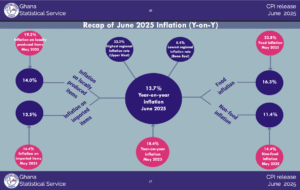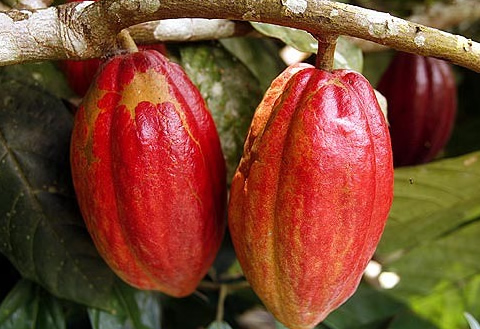
By Juliet ETEFE ([email protected])
Year-on-Year headline inflation dropped to 13.7 percent in June 2025, down from 18.4 percent in May – marking the sixth consecutive month of decline and the lowest rate since December 2021.
This consistent disinflation signals a sustained return to price stability, providing some relief to households and enhancing planning certainty for businesses and investors.
The monthly inflation rate saw a notable shift, recording a deflation of -1.2 percent in June compared to a 0.7 percent inflation rate in May, according to the latest release from the Ghana Statistical Service (GSS).
Speaking at the release, Government Statistician Dr. Alhassan Iddrisu noted that the downward trend reflects both seasonal effects and the impact of ongoing fiscal and monetary policy interventions.
“We are seeing signs of real traction from the measures taken over the past year. But we must continue on this path to consolidate the gains and avoid a rebound,” Dr. Iddrisu said.
Government’s inflation target for 2025 remains 11.9 percent by year-end.

Food and non-food inflation
Food inflation eased significantly to 16.3 percent in June from 22.8 percent in May. Non-food inflation also declined to 11.4 percent from 14.4 percent over the same period.
Food and non-alcoholic beverages contributed 7 percentage points to the overall 13.7 percent headline rate. Meanwhile, prices of non-food items – particularly housing, utilities, and clothing -also moderated.
On a month-on-month basis, the general price level of food items dropped by 0.5 percent while that of non-food items fell by 1.8 percent.
Housing, water, electricity, gas and other fuels recorded an inflation rate of 24.9 percent – up from 21.6 percent in May – making it one of the few divisions to register an increase.
Goods vs services inflation
Goods inflation continued to outpace that of services, as in June, inflation for goods declined to 15.2 percent from 20.1 percent in May while services inflation fell to 9.3 percent from 14.3 percent.
Goods accounted for over 70 percent of the overall inflation rate, reflecting persistent cost pressures in consumer items – particularly essentials such as food, rent and energy-related services.
Within the goods category, key contributors included food staples, charcoal and household consumables. Services inflation, while lower, remained elevated in areas such as housing, refuse disposal and cultural services.
Core inflation – which strips out volatile items like food, energy and transport – dropped sharply to 8.3 percent in June from 19.5 percent in May. This signals a broad-based decline in underlying inflationary pressures.
Locally produced vs imported goods
Inflation for locally produced items declined to 14 percent in June from 19.2 percent in May. For imported items, inflation also dropped to 12.5 percent from 16.4 percent.
However, the monthly deflation was steeper for imported items at -1.8 percent compared to -1.1 percent for local products – suggesting a stronger price correction for imports, likely reflecting a relatively stable exchange rate environment.
Regional performance
At the regional level, Bono East recorded the lowest inflation rate at 8.4 percent, down from 16.5 percent in May. In contrast, Upper West Region continued to register the highest inflation at 32.3 percent – though this was down from 38.1 percent the previous month.
Key contributors in the Upper West Region included housing and utilities – which saw price increases of over 120 percent – and food, which remained elevated despite a national decline.
Greater Accra (12.2%), Ashanti (15.2%) and Eastern (12.2%) Regions were among the top contributors to national inflation due to their higher population weights in the CPI basket.
Top price drivers
Top contributors to June inflation included rent payments (86% y-on-y), electricity (139.3%), and refuse disposal (130.9%). Charcoal, river fish and resold water also featured prominently among inflation drivers.
The post Inflation drops to 13.7% in June, lowest since Dec. 2021 appeared first on The Business & Financial Times.
Read Full Story














Facebook
Twitter
Pinterest
Instagram
Google+
YouTube
LinkedIn
RSS